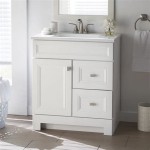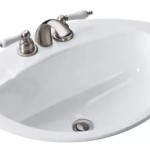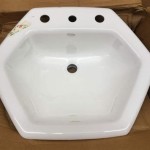36 Inch Bathroom Vanity Sink Combos: A Comprehensive Guide
The 36-inch bathroom vanity sink combo represents a popular choice for residential bathrooms, offering a balance between space efficiency and functionality. This size is particularly well-suited for guest bathrooms, smaller master bathrooms, or powder rooms where maximizing floor space is a priority. The "combo" aspect signifies that the vanity cabinet and sink are designed and often sold together, ensuring a cohesive aesthetic and simplifying the installation process.
Selecting the appropriate 36-inch bathroom vanity sink combo requires careful consideration of several factors, including material, style, storage capacity, and plumbing compatibility. Understanding the nuances of these considerations is crucial for making an informed decision that aligns with both practical needs and design preferences.
Key Point 1: Exploring Material Options for Durability and Aesthetics
The material composition of a bathroom vanity sink combo significantly impacts its longevity, maintenance requirements, and overall aesthetic appeal. Common materials used in the construction of both the cabinet and sink components include solid wood, plywood, MDF (Medium-Density Fiberboard), and various countertop materials like ceramic, porcelain, marble, granite, quartz, and cultured stone.
Solid wood vanities, typically crafted from hardwoods like oak, maple, or birch, are known for their durability and natural beauty. They offer a premium aesthetic and are resistant to warping and cracking when properly sealed and maintained. However, solid wood vanities are generally more expensive than those made from other materials and require more diligent care to prevent water damage.
Plywood, engineered from layers of wood veneer bonded together, provides a stable and relatively moisture-resistant alternative to solid wood. High-quality plywood is less prone to warping than solid wood and offers a good balance between durability and cost. It is often used as the core material for vanity cabinets, particularly in areas susceptible to humidity.
MDF is another engineered wood product made from wood fibers bonded with resin. It is a cost-effective option that provides a smooth surface for painting or laminating. While MDF is less expensive than solid wood or plywood, it is also more susceptible to water damage and should be carefully sealed to prevent swelling and deterioration.
Countertop materials offer a diverse range of aesthetic and functional characteristics. Ceramic and porcelain sinks are durable, stain-resistant, and easy to clean, making them a practical choice for high-traffic bathrooms. Marble and granite countertops offer a luxurious aesthetic and are highly resistant to heat and scratches. However, they require regular sealing to prevent staining from spills. Quartz countertops are engineered from quartz crystals and resin, providing a durable and low-maintenance surface that mimics the look of natural stone. Cultured stone is a composite material that offers a cost-effective alternative to natural stone while providing similar aesthetic qualities.
The choice of material should reflect the overall design aesthetic of the bathroom and the level of durability required to withstand daily use. For example, a bathroom with high humidity levels may benefit from a vanity with a plywood or MDF core and a stone countertop, while a bathroom with lower humidity levels may allow for the use of a solid wood vanity.
Key Point 2: Understanding Sink Mounting Styles and Their Implications
The sink mounting style is a crucial design element that contributes to both the aesthetic appeal and functionality of the bathroom vanity. Common sink mounting styles include undermount, drop-in (or top-mount), vessel, and integrated sinks. Each style offers distinct advantages and disadvantages in terms of aesthetics, ease of installation, and cleaning convenience.
Undermount sinks are installed beneath the countertop, creating a seamless transition between the sink and the countertop surface. This style offers a clean and contemporary aesthetic and simplifies cleaning, as spills and debris can be easily wiped directly into the sink. Undermount sinks typically require a solid surface countertop like granite, quartz, or marble to provide adequate support and a watertight seal.
Drop-in sinks, also known as top-mount sinks, are installed from above the countertop, with the rim of the sink resting on the countertop surface. This style is relatively easy to install and can be used with a wider range of countertop materials, including laminate and tile. However, drop-in sinks can create a slight lip around the sink edge, which may trap dirt and debris.
Vessel sinks sit on top of the countertop, resembling a decorative bowl. This style offers a unique and eye-catching aesthetic and can be used to create a focal point in the bathroom. Vessel sinks require a dedicated faucet that sits either on the countertop or extends from the wall. The countertop height needs to appropriately accommodate the height of the vessel sink for comfortable use.
Integrated sinks are seamlessly molded into the countertop, creating a single, continuous surface. This style offers a sleek and modern aesthetic and simplifies cleaning, as there are no seams or crevices to trap dirt and debris. Integrated sinks are typically made from materials like solid surface acrylic or cultured stone.
The choice of sink mounting style should be based on the desired aesthetic, the type of countertop material, and the ease of installation. For example, an undermount sink complements a granite countertop and creates a clean and modern look, while a vessel sink can add a touch of elegance to a traditional bathroom design.
Key Point 3: Evaluating Storage Options and Functionality
A 36-inch bathroom vanity sink combo should provide adequate storage space for toiletries, towels, and other bathroom essentials. The storage capacity and configuration of the vanity cabinet significantly impact its functionality. Common storage options include drawers, cabinets, shelves, and open storage areas.
Drawers are ideal for storing smaller items like toiletries, makeup, and hair accessories. They provide easy access to stored items and help keep the countertop clutter-free. Drawers should be equipped with smooth-gliding mechanisms and have sufficient depth to accommodate various items.
Cabinets offer ample storage space for larger items like towels, cleaning supplies, and extra toilet paper. They can be equipped with adjustable shelves to customize the storage space to suit specific needs. Soft-close hinges are a desirable feature that prevents slamming and extends the lifespan of the cabinet doors.
Shelves provide open storage space for displaying decorative items or storing frequently used items like towels and washcloths. Open shelving can add visual interest to the bathroom and create a more spacious feel.
Some vanity sink combos incorporate a combination of drawers, cabinets, and shelves to maximize storage versatility. The configuration of the storage space should be carefully considered based on the types of items that need to be stored and the desired level of organization.
In addition to the amount of storage space, the accessibility of the storage areas is also an important consideration. Drawers and cabinets should be easy to open and close, and shelves should be positioned for easy access. The placement of plumbing fixtures can also impact the available storage space, so it is essential to consider the plumbing configuration when selecting a vanity sink combo.
The selection of a 36-inch bathroom vanity sink combo necessitates a thorough assessment of spatial constraints, aesthetic preferences, and functional requirements. The interplay between material selection, sink mounting styles, and storage configurations significantly influences the overall value and suitability of the vanity for a given bathroom environment. Careful consideration of these factors ensures a harmonious integration of the vanity into the bathroom design, enhancing both its practicality and visual appeal.

36 White Bathroom Vanity With Sink Combo Ceramic Countertop Cabinet Mirror Faucet Drain Com

Home Decorators Collection Sonoma 36 In W X 22 D 34 H Single Sink Bath Vanity Dark Charcoal With Carrara Marble Top 8105100270 The Depot

Churanty 36 Bathroom Vanity Cabinet With Sink Combo Set Soft Closing Door And Adjustable Storage Shelves Retro Espresso Com

Ravenna 36 Single Sink Bathroom Vanity Combo Set Homebeyond

Magic Home 36 In Transitional Green Bathroom Vanity Cabinet Freestanding Combo Set With Single Sink Top Shaker Drawers Cs Wf195779aad The Depot

36 Bathroom Vanity And Sink Combo Cabinet Undermount Ceramic Vessel Com

Bellemave 36 Bathroom Vanity With Resin Sink Set Usb Two Shallow Drawers One Deep Drawer Door And Basin Combo In 2024

Lumisol 36 Single Bathroom Vanity With Sink Top Modern Combo Free Standing Wood Cabinet Drawers And Shelves Soft Closing Doors Yahoo Ping

Project Source 36 In Gray Single Sink Bathroom Vanity With White Cultured Marble Top The Vanities Tops Department At Com

36 Bathroom Vanity Cabinet With Sink Top Combo Set
Related Posts







